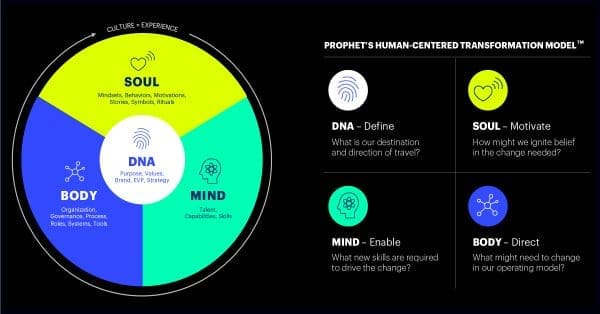BLOG
How Verbal Branding Can Amplify Your Transformation
Story-telling, innovation and personalization all help differentiate, deliver and win in the market.
With rising customer expectations, companies across industries are investing in innovative experiences, digital marketing capabilities, and organizational change to attract and retain talent. But with fast-moving timelines and competing demands, they can’t always invest in storytelling, a key component in influencing and driving change.
Verbal branding—or the strategic deployment of language through tools like voice, messaging, content strategy and copy—plays a key role in optimizing the return on these investments, ensuring companies make thoughtful choices about their communications in these high-impact moments.
In this article, we offer three imperatives for organizations to consider when using their verbal branding to differentiate, deliver their promise, and win in the market.
Meet Customers’ Expectations for Personalized, Connected Communications
More and more, customers expect a consistent experience across channels – from mentioning a brand on Twitter to calling customer service. They expect their interactions to be seamless, with one channel easily picking up a conversation started in another (for example, starting in a chatbot and following up by phone—these two interactions use different systems but are ideally connected by a centralized customer data platform to create a unified customer picture). In short, customers want brands to recognize them as the same person across different channels and interactions.
While these channels and interactions have different formats, functions and requirements, they need to feel creatively and strategically cohesive. The implication for brands is ensuring that all these channels—whether automated or human-enabled—are on-voice and on-message.
But cohesive doesn’t necessarily mean uniform. The best service interactions modulate based on user sentiment. They can sense excitement, frustration, confusion, and adapt as needed. This can be achieved through both human and digital capability.
For example, it can be as simple as empowering call center reps with cues on how to identify customer archetypes based on emotion and providing discrete service journeys and scripts for them. This is particularly important for industries that customers approach with sensitivity or trepidation, such as financial services or healthcare.
“Verbal branding plays a key role in optimizing the return on these investments, ensuring companies make thoughtful choices about their communications in these high-impact moments.”
At the same time, brands using natural language processing tools, such as in-chatbot experiences, can similarly “train” their Natural Language Processing (NLP) tool to not only identify the customer’s desired “job to be done,” but to detect underlying emotion and adapt responses accordingly. For example, a chatbot that can sense a customer’s frustration about a delayed order, offer sympathy and quickly route them to live chat support, can help repair the customer’s brand perception in a tenuous moment.
Invest in Innovation—and its Expression
While many companies prioritize investing in new products and experiences, sometimes they don’t consider the importance of the words used to guide their audiences through them.
Rather than viewing product and expression as separate steps in the process, they should be developed in tandem as complementary assets, working together to shape how customers interact with and perceive the brand. Effective verbal expression (in this case, UX writing) bridges the gap between the layout and usability of the product.
Regardless of how brilliantly developed the product is, without clear and engaging written cues, the audience (customers or employees) may struggle to use or navigate it. More broadly, however, approaching innovation solely through a product lens misses an opportunity to embody the brand’s verbal identity. Effective copy can help a brand make a human connection with users that’s often not possible through design alone.
Brands should develop on-voice UX writing that has clear user goals in mind and reflects the likely emotional mindset of customers at various stages of their journey. Using this approach, copy can help drive self-progression or clarify complex topics in an engaging, on-brand manner—without disrupting the experience.
Brands that harness the strategic prowess of UX writing will excel at forming closer bonds with customers over brands who merely prioritize function in their innovations.
Use Storytelling to Galvanize Employees Around a Shared Vision, Meet Mandates and Drive Retention
The “Big Quit” is upon us. In an increasingly competitive talent market following a year that has upended what work looks like, employee expectations are rapidly changing. To meet this upheaval, impactful verbal expression can play a vital role in shaping experiences that respond to employee needs and catapult desired organizational change.
From crafting a meaningful shared vision to galvanizing employee sentiment, retaining key talent and attracting prospective candidates, transformational organization change requires a comprehensive accompanying voice and messaging strategy.
For example, how might we excite employees about new innovations? Inspire employees to care about new internal initiatives? Bring new hires into the corporate culture and values? Present a compelling case for change?
Like customers, employees are not a monolith. Different customer segments have different needs and respond to different ways of messaging. Companies with robust customer segmentation strategies can take the same approach with their employees, creating targeted messaging to meet specific employee audience group needs.
Taking a strategic messaging approach allows brands to connect external brand ambition to internal employee communication and experience, ultimately aligning the organization behind shared ambition, values, and purpose.
FINAL THOUGHTS
Words shape how we see and experience the world. Now more than ever, verbal branding can play a crucial role in driving and amplifying transformational change. To capitalize on this opportunity, brands should prioritize verbal expression when shaping service and support channels, developing new product experiences and engaging employees along the way.


















